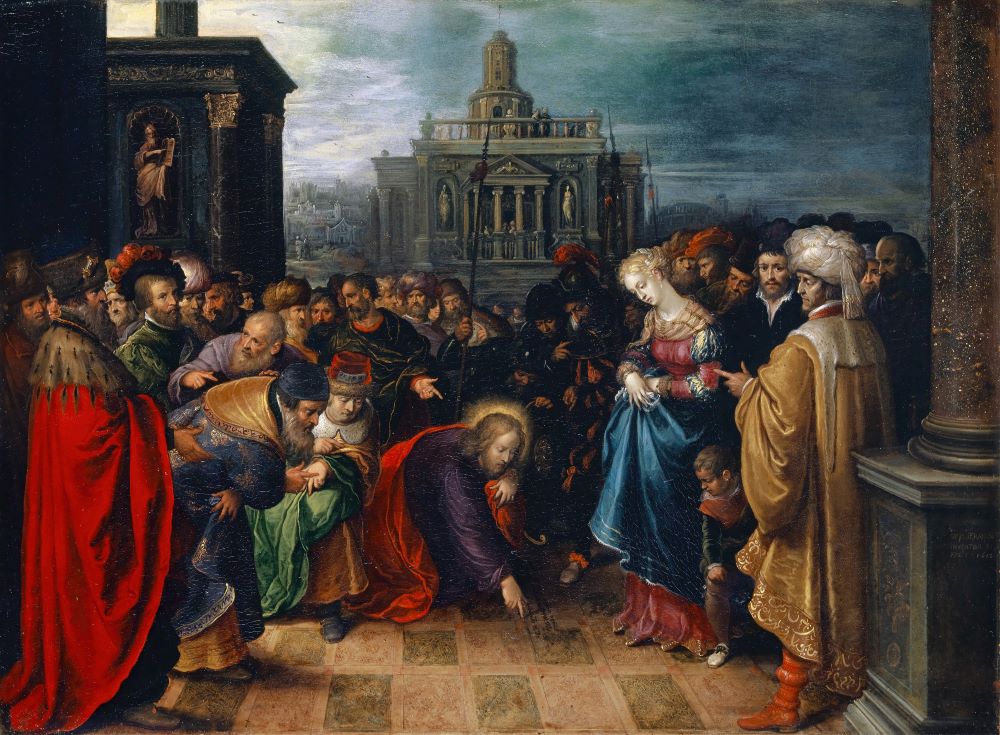
"Christ and the woman taken in adultery" (1612) by Frans Francken the Younger (Artvee)
Last week we heard about a wild child whose self-destructive behavior ended up sending him right back into the arms of his father. This week, John tells us the same story with different characters. In this account, self-righteous people figure they can ensnare Jesus between fidelity to tradition and mercy.
First, a look at tradition. The Hebrew scriptures give a rather mixed message on the question of prostitution, but the strict law demanded that adultery be proven and then punished by death — for both of the people involved (Deuteronomy 20:10). In that light, the group testing Jesus was rather remiss: they did not bring witnesses, nor, most pointedly, did they bring the man who should have been stoned with her.
When the morality posse pushed Jesus to pronounce a judgment, he refused — just as he would when Pilate demanded an answer (John 19:9). Instead of letting himself be caught in their trap, Jesus bent down and began to write on the ground with his finger. The point of this gesture has little to do with what he wrote, but rather how he did it. His antagonists were talking about the law, and they all knew that their law came from the finger of God (Exodus 31:18). Jesus demonstrated his authority over the law and refused to condemn the woman.
Then, in a marvelous, merciful turning of the tables, Jesus confronted the accusers, inviting anyone who had never sinned to begin the stoning. As soon as prayerful people would have heard that, Psalm 130:3 could have come to mind: "If you, Lord, mark iniquity, Lord, who can stand?" In spite of the theatrical scene they had contrived, no one dared make a public declaration that they were sinless; the others knew them far too well. What an embarrassment! Their righteousness boomeranged.
The woman in this story was nameless and had been treated as an object from the time the scene opened. The accusers barely paid her any attention. They used her as nothing more than a prop, disregarding her personhood. Yet Jesus dealt with them as human beings. He didn't retort or defend either himself or her. One can only imagine the look on his face when he dusted off his finger and stood up to look them in the eye. Did he look angry or did he gaze on each of them with compassion? Which would have been harder on them, reprimand or benevolence? (Think of the father greeting his wayward son with love that didn't even mention the words sin or forgiveness.)
Advertisement
John tells us that after the troupe disappeared, Jesus "straightened her up" and, perhaps with a great grin, he asked her, "Where are they? Has no one condemned you?" She replied, "No one, Lord."
What a declaration! Standing before the man she called Lord, she herself proclaimed that no one condemned her. At that moment she could understand Isaiah's joyful proclamation, "Thus says the Lord who opens a way in the sea . . . Remember not the events of the past, the things of long ago consider not; see, I am doing a new thing."
Note that Jesus did not ask her to repent before he said, "Neither do I condemn you." The very experience of his care for her would bring about her metanoia. After this, she knew her own value and was beyond selling herself out for anyone, especially anyone who would abandon her as her illicit partner had obviously done. She had also experienced a mercy too great to keep to herself. Like the woman at the well (John 4), love would impel her to become an evangelizer.
St. Paul knew the same truth she had discovered. He admitted he had no righteousness of his own. Everything he was flowed from "the supreme good of knowing Christ Jesus." Because of that, no title or prestige was worth more than dung — literally. Both Paul and this woman could humbly glory in knowing they were loved beyond all reason.
As we move toward Holy Week, these readings invite us to approach the mysteries with eyes ready to perceive God's love working through everything — even the worst events imaginable. At every moment, God is doing something new. We're invited to recognize its springing forth.
These Scriptures suggest that God does not mark iniquity. Like Jesus raising this woman up or the father putting a ring on his errant son's finger, God's focus is on the future, on what can happen, not what is over and done. That's what Jesus meant by saying, "Go, and from now on, sin no more."
Let us pray that we can approach this Holy Week ready to perceive God's invitation to "sin no more," as an invitation to be ambassadors set on fire by God's creative love and mercy.
